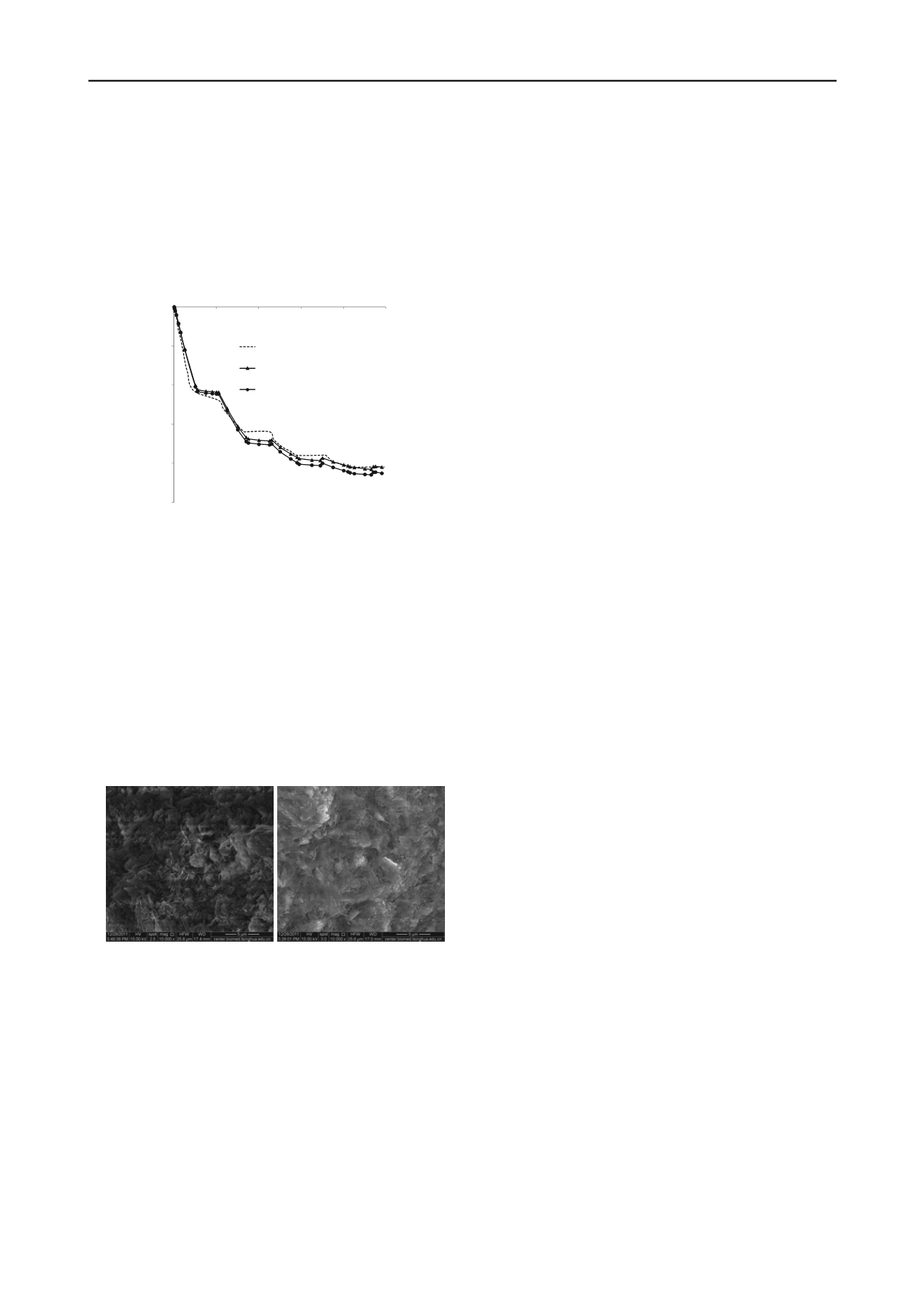
234
Proceedings of the 18
th
International Conference on Soil Mechanics and Geotechnical Engineering, Paris 2013
Proceedings of the 18
th
International Conference on Soil Mechanics and Geotechnical Engineering, Paris 2013
the radius of the model, is compared since the settlement at
other positions are largely influenced by the test apparatus.
The settlement obtained from the numerical model which
considered the variation of the electrical conductivity is smaller
than that obtained from another numerical model in which the
electrical conductivity keeps constant. The result of the model
with variable electrical conductivity agrees better with the
experimental data than the model with constant electrical
conductivity during the consolidation process.
-0.025
-0.02
-0.015
-0.01
-0.005
0
0
20
40
60
80
10
Settlement/m
t
/h
0
Experiment data
Numerical result:variable parameters
Numerical result:constant parameters
Figure 7. Comparison of the numerical model
with the experimental data
5 MICROSCOPIC OBSERVATION
The scanning electron microscopy tests of the soil samples
before and after electro-osmosis were conducted and the
comparison was shown in Fig. 8.
Fig. 8 illustrates that after the electro-osmosis treatment, the
shape of soil particles changed. The content of spherical particle
and flaky particle decreased, and the content of acicular particle
increased, which mean that under the application of the voltage,
the soil particles broke from spherical particle or flaky particle
to acicular particle.
(a)
After electro-osmosis
(b)
Before electro-osmosis
Figure 8. Results of the scanning electron microscopy test.
6 SUMMARY AND CONCLUSIONS
The electro-osmotic consolidation process is investigated by
means of laboratory test and numerical simulation. The
following conclusions can be obtained based on this study.
A laboratory testing facility was developed for the electro-
osmotic consolidation, and the electrical voltage distribution,
soil mass displacement, water discharge and electrical current
were monitored during the testing process. The coupled effect
of mechanical, hydraulic and electrical field, as well as the
nonlinear variation of soil resistance during electro-osmosis was
observed.
A theoretical model for electro-osmotic consolidation is
briefly introduced, and FEM software was developed based on
the theoretical model to describe the electro-osmotic
consolidation process.
The numerical results showed good agreement with the
testing data in terms of ground settlement, indicating the
rationality of the analytical model. It is also shown that the
variations of electrical conductivity have a significant effect on
the consolidation process and the numerical model which
considered the variation of the electrical conductivity agrees
better with the experemental data than the model with constant
electrical conductivity.
The developed software can predict the displacement
behavior of soil mass and provide useful data for system design
of electro-osmosis treatment.
The result of the ESEM test shows that the soil particles
break from spherical particle or flaky particle to acicular
particle because of the applied voltage.
ACKNOWLEDGEMENTS
Financial supports from National Natural Science
Foundation of China (NSFC50978139), National Key Basic
Research Program (2012CB719804), Tsinghua University
(2010THZ02-1), and the State Key Laboratory of Hydroscience
and Engineering (SKLHSE-2012-KY-1) are gratefully
acknowledged.
REFERENCES
Casagrande L. 1948. Electroosmosis in soils.
Geotechnique
1: 159-177.
Casagrande L. 1983. Stabilization of soils by means of electro-osmotic
state-of-art.
J. Boston Civ. Eng. ASCE
69, No. 3, 255–302.
Esrig M.I. 1968. Pore pressures, consolidation and electro-kinetics.
Journal of the Soil Mechanics and Foundation Engineering
Division
,
ASCE
94(SM4), 899- 921.
Hu L. M.. Wu W. L. & Wu, H. 2012. Numerical model of electro-
osmotic consolidation in clay.
Geotechnique
62(6), 537-541.
Jones C. J. F. P., Lamont-Black J., Glendinning S., Bergado D., Eng T.,
Fourie A., Hu L., Pugh C., Romantshuk M., Simpanen S. & Zhuang
Y. 2008. Recent research and applications in the use of electro-
kinetic geo-synthetics. Keynote paper,
Proc. 4th European Geo-
synthetics Conf.
, Edinburgh, UK, Paper No 329, CDROM.
Lewis R. W. & Humpheson C. 1973. Numerical analysis of electro-
osmotic flow in soils.
Journal of the Soil Mechanics and
Foundations Division, ASCE 99(SM8), 603-616.
Li Y., Gong X., Jiao D. & Liu Z. 2009. Experimental study on two-
dimensional electro-osmotic consolidation of soft clay.
Chinese
Journal of Rock Mechanics and Engineering
28(2), 4034-4039. (in
Chinese)
Mitchell J. K. & Soga K. 2005. Fundamentals of soil behavior. 3rd
Edition, John Wiley & Sons, USA.
Rittirong A. & Shang J. Q. 2008. Numerical analysis for electro-osmotic
consolidation in two-dimensional electric field.
Proc. 18th ISOPE,
Vancouver
, Canada, 566-572.
Shang J.Q. 1998. Electroosmotic enhanced preloading consolidation via
vertical drains.
Can. Geo. J.
35(3), 491-499.
Shang J. Q. & Dunlap W. A. 1998. High voltage reinforcement of
ground anchors.
J. Geotech. Geoenviron. Eng. ASCE
124, No. 9,
840–845.
Su J. Q. & Wang Z. 2003. Theory of two-dimensional electro-osmotic
consolidation of soils.
Geotechnique
53(8), 759-763.
Wan T. Y. & Mitchell J. K. 1976. Electro-osmotic consolidation of soils.
J. Geotech. Eng. Div., ASCE
102(5), 473–491.
Wu H. & Hu L. M. 2012. Analytical models of the coupling of vacuum
preloading and electro-osmotic consolidation for ground
stabilization.”
J. Tsinghua Univ. (Sci. and Tech.)
52(2), 182-185.
(in Chinese)
Xu W., Liu S. H., Wang L. J. & Wang J. B. 2011. Analytical theory of
soft ground consolidation under vacuum preloading combined with
electro-osmosis.
Journal of Hohai University (Natural Sciences)
39(2), 169-175. (in Chinese)


